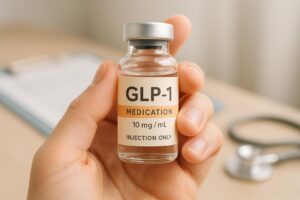What Does GLP-1 Stand For? Unpacking the Role of Glucagon-Like Peptide-1 in Weight Loss and Diabetes Management

Have you ever wondered how some hormones can play pivotal roles in managing weight and blood sugar levels? One such hormone is glucagon-like peptide-1 (GLP-1). As we delve into the fascinating world of GLP-1, we will explore its functions, the science behind it, and how it fits into our personalized weight loss solutions at TrimRx.
Introduction
GLP-1 is garnering attention in both the medical community and among individuals seeking effective weight management strategies. According to recent studies, GLP-1 can help control blood sugar levels and promote weight loss, making it a key player in managing type 2 diabetes and obesity. In fact, the FDA has approved several medications that utilize GLP-1’s properties to aid in these areas.
Understanding what GLP-1 is and how it functions is essential for anyone interested in optimizing their health and wellness journey. This blog post aims to provide a comprehensive overview of GLP-1, including its definition, mechanism of action, potential benefits, and its role in TrimRx’s personalized weight loss programs.
By the end of this post, you will have a clearer understanding of GLP-1 and how it can be part of a successful weight loss journey, alongside our personalized, medically supervised care. Together, let’s explore the science behind this remarkable peptide and its implications for health and well-being.
What is GLP-1?
GLP-1, or glucagon-like peptide-1, is a 30- to 31-amino-acid peptide hormone produced in the intestinal L-cells. It is released into the bloodstream in response to food intake and plays several critical roles in glucose metabolism and appetite regulation.
The Discovery of GLP-1
GLP-1 was first identified in the early 1980s during research focused on proglucagon, a precursor to several peptides, including glucagon. Researchers discovered that proglucagon could be processed into GLP-1, which was found to have significant physiological effects, including stimulating insulin secretion and inhibiting glucagon release, making it a crucial component in the regulation of glucose homeostasis.
How Does GLP-1 Work?
The primary actions of GLP-1 include:
-
Enhancing Insulin Secretion: GLP-1 stimulates the pancreas to release insulin in a glucose-dependent manner, meaning that it helps to increase insulin levels when blood sugar is high, thereby reducing the risk of hypoglycemia.
-
Inhibiting Glucagon Secretion: It suppresses the secretion of glucagon, a hormone responsible for increasing blood glucose levels, especially during fasting.
-
Slowing Gastric Emptying: GLP-1 slows down the rate at which food leaves the stomach, which helps to prolong feelings of fullness and reduce appetite.
-
Promoting Satiety: By acting on the brain, GLP-1 enhances the sensation of fullness, leading to reduced food intake.
The combined effect of these actions helps in managing blood sugar levels and controlling body weight, making GLP-1 an essential focus in the treatment of type 2 diabetes and obesity.
The Role of GLP-1 in Weight Loss
At TrimRx, we understand that sustainable weight loss involves more than just diet and exercise; it’s about understanding the science behind how our bodies work. GLP-1 plays a vital role in this process.
GLP-1 Agonists: A New Frontier in Weight Loss
GLP-1 receptor agonists are medications that mimic the effects of GLP-1. They are designed to provide the benefits of GLP-1 while overcoming its short half-life in the bloodstream. Some of the most common GLP-1 receptor agonists include:
- Semaglutide (Ozempic®): Approved for the treatment of type 2 diabetes and chronic weight management.
- Liraglutide (Saxenda®): Used for weight loss and the management of type 2 diabetes.
- Dulaglutide (Trulicity®): Another approved medication for managing diabetes and aiding in weight loss.
These medications work by mimicking the actions of GLP-1, enhancing insulin secretion, inhibiting glucagon release, and promoting a feeling of fullness, which can significantly aid in weight loss efforts.
How GLP-1 Supports Sustainable Weight Loss
Using GLP-1 receptor agonists as part of a weight loss program can help individuals achieve their goals in several ways:
- Appetite Regulation: By increasing feelings of fullness and reducing hunger, GLP-1 can help individuals consume fewer calories without feeling deprived.
- Blood Sugar Management: By helping control blood sugar levels, GLP-1 receptor agonists can reduce cravings related to blood sugar spikes and crashes, making it easier to stick to a healthy eating plan.
- Metabolic Benefits: GLP-1 receptor agonists have been associated with improved lipid profiles and reduced cardiovascular risks, which can be particularly beneficial for individuals with obesity or diabetes.
At TrimRx, we believe that a comprehensive approach tailored to individual needs is vital for success. This is why we offer a free assessment quiz to help determine eligibility for our prescription weight loss medications, including GLP-1 receptor agonists. Those interested can take our free quiz here.
GLP-1 and Its Broader Implications in Health
The benefits of GLP-1 extend beyond weight loss and diabetes management. Research has indicated that GLP-1 may have protective effects on the cardiovascular system and the brain, making it a multifaceted hormone worth exploring further.
Cardiovascular Health
GLP-1 receptor agonists have been linked to cardiovascular benefits, including:
- Reduced Risk of Cardiovascular Events: Studies suggest that medications like liraglutide and semaglutide can lower the risk of major cardiovascular events, making them valuable for patients with type 2 diabetes who often face increased cardiovascular risks.
- Improved Heart Function: GLP-1 receptor activation has been associated with improved heart function and reduced inflammation, contributing to overall cardiovascular health.
Neuroprotective Effects
Recent studies have indicated potential neuroprotective effects of GLP-1, which may play a role in conditions like Alzheimer’s and Parkinson’s disease. The neuroprotective actions of GLP-1 include:
- Reduction in Neuroinflammation: GLP-1 may help mitigate inflammation in the brain, potentially slowing the progression of neurodegenerative diseases.
- Enhanced Neurogenesis: GLP-1 has been shown to promote the growth and survival of neurons, which is critical for cognitive function.
As we continue to explore the myriad effects of GLP-1, it becomes increasingly clear that its role extends beyond the management of diabetes and obesity.
The TrimRx Approach: Personalized Weight Loss Solutions
At TrimRx, our journey began with a vision to help individuals embrace healthier lifestyles through innovative telehealth solutions combined with evidence-based medical care. Our commitment to safety, transparency, and personalized care is reflected in our offerings.
Comprehensive Services
Our weight loss programs include:
- Personalized Treatment Plans: After completing our free assessment quiz, we provide tailored recommendations based on individual health factors and goals.
- Medical Supervision: Our programs are designed to be safe and effective, underpinned by medical guidance and support throughout the journey.
- Unlimited Support: We understand that weight loss is a journey, and we provide ongoing support to help navigate challenges and celebrate successes.
- Lab Work and Monitoring: We conduct regular lab work to monitor progress and adjust treatment plans as necessary.
If you’re interested in exploring how GLP-1 receptor agonists can fit into your weight loss journey, we encourage you to take our free quiz here.
Quick-Access Supplements for Support
In addition to our personalized programs, we offer quick-access supplements to support overall wellness during your weight loss journey. Our products, such as:
- GLP-1 Daily Support: Designed to complement a weight loss regimen.
- Weight Loss Boost: Helps enhance your weight loss efforts.
These supplements are available for immediate purchase and can serve as valuable tools in your weight loss arsenal.
Conclusion
In summary, GLP-1 stands for glucagon-like peptide-1, a hormone with compelling attributes that play a significant role in weight management and blood sugar regulation. By understanding the mechanisms of GLP-1 and its implications for health, we can better appreciate how it fits into personalized weight loss strategies at TrimRx.
As we continue to advance in our understanding of GLP-1 and its potential, we remain committed to offering safe, effective, and personalized weight loss solutions. If you’re ready to take the first step in your weight loss journey, consider taking our free assessment quiz and exploring our tailored programs designed for individuals seeking sustainable change.
FAQ
What is GLP-1?
GLP-1, or glucagon-like peptide-1, is a hormone produced in the intestines that helps regulate blood sugar levels and appetite.
How does GLP-1 help with weight loss?
GLP-1 promotes feelings of fullness, enhances insulin secretion, and inhibits glucagon release, which collectively help to reduce food intake and manage body weight.
Are there medications that use GLP-1?
Yes, several GLP-1 receptor agonists like semaglutide and liraglutide are approved for the treatment of type 2 diabetes and obesity, helping individuals achieve better health outcomes.
How can I access TrimRx’s weight loss solutions?
You can start by taking our free assessment quiz to determine eligibility for our personalized weight loss medications and programs. Access the quiz here.
What other support does TrimRx offer?
In addition to personalized programs, we offer quick-access supplements such as GLP-1 Daily Support and Weight Loss Boost to enhance your weight loss efforts.
By leveraging the power of GLP-1 and our comprehensive support, we can work together towards achieving your weight loss goals.

Transforming Lives, One Step at a Time
Keep reading
GLP-1 Medication Side Effect Checker
Worried about GLP-1 medication side effects? Use our free checker for Semaglutide, Liraglutide, and more to learn what to expect and stay informed!
GLP-1 Dose Titration: Research Insights
Gradual GLP-1 dose increases balance weight loss and GI side effects; personalized titration and monitoring improve real-world outcomes.
Wave Life Sciences unveils Phase I results for obesity treatment
Wave Life Sciences’ single-dose RNA therapy showed 4% total body fat reduction and promising Phase I results.



